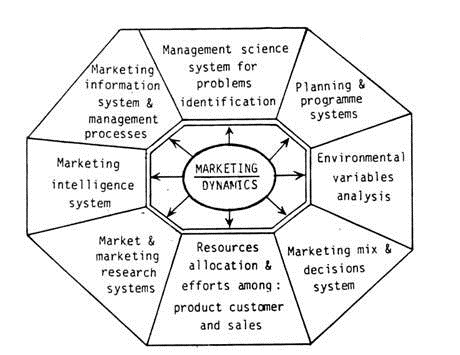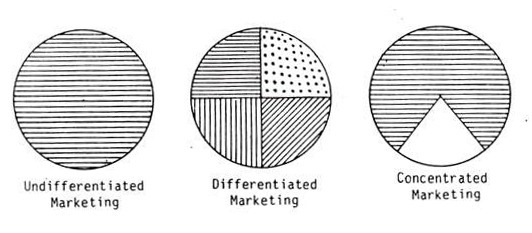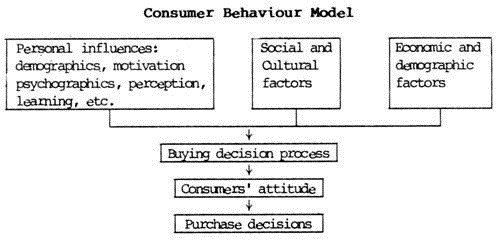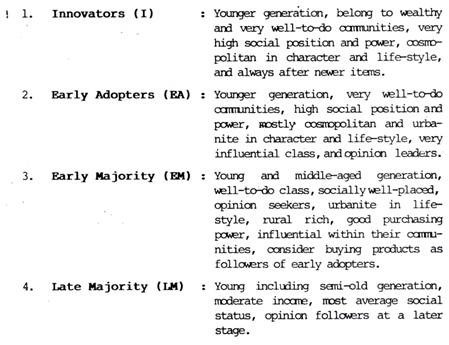Some of the frequently asked exam questions on the dynamics of marketing are as follows:
Q.1. Define the term marketing dynamics and explain some of its different aspects or elements.
Ans. The entire process of marketing management science system right from the ascertainment and assessment of marketing environment via analysis of market segments, marketing channels, competition, publics, and micro-environment variables (such as demographic, social, economic, political, and cultural) to the marketing decisional phenomena involved in the processes of planning, formulation, programming, guidelines, actions, evaluation and control necessary for an appropriate marketing strategy and policy is known as marketing dynamics.
We can, thus, state that the elements of marketing dynamics include everything concerning the study of markets and marketing forces from the aspects of business environment and business development, with an appropriate emphasis on the consumer-oriented concept of marketing to be practiced by a firm in its day-to-day business operations.
ADVERTISEMENTS:
The important aspects or elements of marketing dynamics are discussed below:
1. Marketing management science system:
It is concerned with the problem identification, problem definition, model building, model testing, model application and refinement for clarifying the intricacies of the marketing process.
2. Marketing intelligence system:
ADVERTISEMENTS:
It is concerned with the current and up-to-date information about the external as well as internal environment to be kept by the marketing and other executives of a company in order to keep pace with the changing conditions. This system is more allied to marketing environmental variables analysis, and also to the market and marketing research systems.
3. Marketing information system:
It is a continuing and interacting structure of people, equipment, and procedures to gather, sort, analyse, evaluate, and distribute pertinent, timely and accurate information for use by the marketing decision-makers to improve their marketing planning, execution and control.
The system makes use of internal accounting system, external environmental variables, and of the systems of marketing intelligence and marketing research with a view to performing the fundamental process of planning, organising, staffing, directing, co- ordination and control involved in the management of a total marketing system.
Q.2. What are the kinds of market segmentation on the basis of buyer’s characteristics?
Ans. The behaviour of buyers may be identical in certain respects but not exactly the same on account of demographic and socio-economic and cultural differences.
The products and their market segments are, therefore, to be addressed and determined in the light of buyers’ needs, habits, customs, and preferences. Based on the characteristics of buyer behaviour, the market segmentation can be developed and practiced under three alternative strategies or bases.
These are discussed below:
ADVERTISEMENTS:
1. Market aggregation:
This is also known as ‘undifferentiated marketing’. The term referred to here is the policy of combining together all the markets into one, where the markets may be of local or regional or national or international type. In other words, such markets are not differentiated but are treated under one class. So, this type is altogether different from market segmentation.
The firms which have monopoly business for their products restore to market aggregation policy. They consider all categories of buyers into one group. This type or concept is useful to those firms which intend to economise the scale of operations for their standardised products. This concept of marketing does not work well in the case of consumer-oriented markets.
2. Concentrated marketing:
ADVERTISEMENTS:
It is a combination of both types, aggregation and segmentation. It also refers to the marketing efforts and activities being concentrated in a few markets where the firm wishes to compete with other rival firms.
This method is suitable to be applied in case of new product positioning. Philip Rotler has clarified these concepts in the following diagrams:
Q.3. Distinguish between marketing research and market research.
ADVERTISEMENTS:
Ans. Very often the terms marketing research and market, research are interchangeably used. But their meanings are different firm each Other. Market research is one of the elements of the total marketing research.
Market research, simply put, is the search and research of the market aimed at studying the information with respect to:
(i) Consumers’ demands;
ADVERTISEMENTS:
(ii) Existing and potential consumers;
(iii) Nature, size, and potentiality of markets;
(iv) Consumers’ reaction to existing and new products, and
(v) Competitors and the degree of competition, etc.
On the other hand, the concept of marketing research is global, and requires an investigation and analysis of the whole marketing process from the broadest possible point of view of the term. Without having adequate information base relating to the current conditions and future trends, managerial decisions are difficult to be made.
Facts are needed for better decision-making, for better planning, and for- better programming. Marketing research gathers the facts for all phases of marketing activity and analyses them for the orientation of the business. To sum up, marketing research is a systematic, objective, and exhaustive search for and study of the facts relevant to any problem in the field of marketing.
ADVERTISEMENTS:
Q.4. What are the scope and objectives of market research.
Ans. The following are considered inter-alia, the scope and objectives of market research:
1. To identify the potential markets.
2. To define the market, geographically and otherwise.
3. To know about the consumers, their purchasing power and their decisive criteria.
4. To determine the needs of the market realised and unrealised.
ADVERTISEMENTS:
5. To ascertain the extent of satisfaction and dissatisfaction of customers with the existing and/or new products.
6. To forecast the share of the market that can be captured; that is, to forecast sales quantity and value.
7. To obtain knowledge about:
(i) Competitors and their products,
(ii) Profitability of different market segments,
(iii) Demand of different markets,
ADVERTISEMENTS:
(iv) Customer’s services required, and
(v) Changes in the market and the reasons therefor.
8. To assess the strategy, strength, and policy of the competitors.
9. To select: appropriate advertising and publicity media, preferable channels of distribution, and the markets that need attention under certain circumstances.
10. To determine the quantum of inventories to be maintained at the points of distribution for further transmission to ultimate users.
Q.5. What do you understand by the term ‘Buyer Behaviour’? Also give the model of consumer behaviour.
ADVERTISEMENTS:
Ans. The consumer or buyer behaviour is extremely important for an effective marketing -planning. The success or failure of marketing depends largely on target consumer’s individual and group reaction that manifest in the buying patterns. The buyer behaviour is concerned with the study of factors that influence a person to buy or not to buy.
Its concept lies in understanding the consumer and his motives and therefore, involves seeking answers to pertinent questions like: Why exactly a buyer buys or does not buy a particular brand or product? Does a buyer devote much time and study to comprehend the benefits of a product and its services?
Does a buyer buy due to emotion or impulse? Goes a buyer imitate others? What factors does a buyer take into consideration in the buying decision?
It can, therefore, be stated that buying behaviour is an orderly process whereby an individual interacts with his or her environment with the object of making purchase decisions on products and services. In other words the internal factors like needs, motives, perception, attitudes as well as external factors like influences of culture, economy, business, and society direct the behaviour of an individual buyer or consumer.
The model of consumer behaviour is explained differently by different writers.
However, the following diagram explains the common elements or factors in this:
Q.6. State the variables of consumer behaviour.
Ans. The systematic study of consumer behaviour requires consideration of the following important factors:
(1) Demographic factors:
The analysis of ‘these factors helps to understand as to who the consumer or customer is and to what age group he belongs, how well he is educated, whether he belongs to urban or rural areas, whether he is professional or white collar employee or an agriculturist or a manual worker. This study, of course, does not help the marketer to know as to why a consumer buys or does not buy a product.
(2) Economic factors:
These refer to per capita income, disposable income and discretionary income of the consumer, the degree of economic status, the rate of increase in income, the degree of economic inequality and regional differences, and inflation, etc. Knowledge of these factors is essential to understand the consumer groups but it remains a fact that income alone does not influence the consumer market.
(3) Social and cultural factors:
Leading marketing scholars are of the opinion that these factors are important in influencing consumer behaviour. Social factors refer to social class to which a consumer belongs. Studies and researches made in these respects reveal that different social groups buy different types of goods depending upon their social status.
The very rich people buy certain expensive goods such as luxury cars, luxury houses, art and paintings and very expensive consumer goods which reflect their status. The middle class which constitutes the largest segment buy less expensive goods and services, whereas the working community buy very simple aid cheap goods.
According to Kotler and Stanton, social factors include ‘reference groups’. They consist of social friends, professional associates, family, club membership, classmates, athletic groups, etc. A consumer buys those goods which his ‘reference group’ buys.
The role of a family needs some explanation here. The family life cycle explains how a consumer’s buying behaviour is influenced. Is he a bachelor or married? Are they young married adults or matured married adults? Do they buy goods jointly or do husband and wife buy independently?
Are toys bought by parents or by the housewife or by housewife and children jointly? Who decides to buy? Therefore ‘who makes the buying decision’ is important.
Cultural factors refer to the behaviour of people as a group. Are they competitive, youth-oriented, and adaptable to change? But it is a fact that culture is difficult to be changed. Culture is one of the factors to be studied for understanding consumer behaviour.
(4) Psychological factors:
These refer to the motives of a buyer. Maslow’s theory of hierarchy of needs is very useful. They are physiological, safety, belongingness, esteem, self-actualisation and aesthetic needs. The products and services must fit these motives and needs of a consumer. These factors also include the consumer attitudes towards products.
Q.7. What do you mean by diffusion process in the context of consumer behaviour research?
Ans. An individual is a creature of society and his buying motive is largely influenced by social and cultural environment around him. The information about new products and services (e.g. Indian Cocking gas for domestic purposes) when introduced in the market spreads to different sections of society and generates a feeling among them to possess or not to possess, to use or not to use, etc.
Thus, the diffusion process in the context of consumer behaviour analysis refers to the social process of information dissemination about the new products or new uses of older products that motivates or inspires the consumers to accept then.
Q.8. Explain the relationship between reference groups and diffusion process.
Ans. Recent researches on consumer behaviour show that most consumers or buyers exhibit their buying motives in relation to their belongingness to sate social groups or family groups.
Knowledge of these groups and their influences provides clues to understand why consumers behave in a Particular way. The process of diffusion of information out products takes place in this manner and thereby the consumers’ attitudes and interests also develop.
According to Rogers, the diffusion process takes the model shown below:
He suggests that the society, firm the marketing view point, can be classified into five groups as indicated in the diffusion curve.
The curve takes the shape of ‘normal distribution’ wherein the Innovators are a minority group (2.5%), Early Adopters’ (13.5%) exhibit strong behavioural attitudes, Early Majority Consumers (34%) follow the style of Early Adopters, late majority Consumers ‘(34%) are slow in showing their interests, and the laggards (16%) exhibit interests at a very late stage of the product life.
The characteristics of the above five social groups, as studied by Rogers, are as follows:
The knowledge about the reference groups, social groups, diffusion process and their characteristic features assists the marketing manager and marketers to predict and appraise the consumer behaviour. The determination and development of target market segments, the policies of marketing and selling, and the direction of marketing efforts and activities are greatly facilitated.
Q.9. What are the important consumer rights that consumerism seeks to protect?
Ans. The important consumer rights include:
(1) Right to choose:
A consumer has a right to choose the best quality products at fair prices;
(2) Right against exploitation:
A consumer has a right against exploitation by unfair trade practices including fraudulent and misleading advertisements;
(3) Right to receive after—sales service:
A consumer has a right for service after sale and for warranties and guarantees;
(4) Right to safety:
A consumer has a right to protect health and safety from the goods and services he buys;
(5) Right to seek redress:
A consumer has a right for the redressal of his grievances, if any;
(6) Right to be informed:
A consumer has a right to be informed of the quality, price, ingredients of the product, operational requirements, possible adverse effects and other pertinent facts relating to the product or service; and
(7) Right to protection:
A consumer has a right to protect and enhance the quality of his life.
Q.10. How far will the consumer protection act 1986 promote consumer rights?
Ans. Apart from this, the Government of India has passed Consumer Protection Act in November, 1986. This is a landmark in the history of consumer movement in India because it is applicable to the whole of India and to all goods. It is not applicable to public enterprises.
It seeks to set up courts in each State with powers to punish the guilty by heavy fine and imprisonment. It seeks to set up elaborate inspectorates to implement this Act. For this purpose, active co-operation of all State Governments is necessary. However it is too early to comment whether it is successful or not. Much ‘depends on the role of public and merchants, and on the honesty of government officials.
One redeeming feature of the above Act is that there is a provision for penalty and imprisonment for managers of manufacturing companies. The Food Adulteration Act is applicable to merchants only.
But the Consumer Protection Act applies to the manufacturing companies so that any defect or impurity of the product at the manufacturing stage can be detected and if proved, the concerned executives can be sent to jail.
The middlemen like wholesalers and retailers can, thus, be excused if the product is defective or harmful at the production stage of the plant. It is important to mention that the Government of India deserves admiration and appreciation for this bold step.
Also about two years ago, the Government of India passed Environmental Act under which a separate Ministry was established to enforce regulation of pollution. It is applicable to the whole of India. In all big cities and towns, pollution has become not only a nuisance but also a dangerous thing.
The public health is affected by contamination of drinking water and food and many have died. In spite of this, this problem continues to be serious even today. It is essential that the Government takes stringent measures to control pollution.
Consumerism in the wider sense includes environmentalism and also refers to the senseless waste of scarce natural resources by the private companies or concerns. The resources of the country must be conserved for long-term growth of the economy. In India, this is a very important public issue.
The leading economist, J.K. Galbraith of U.S.A., has strongly criticized the depletion of resources, pollution of environment, etc. by irresponsible business policies and practices in U.S.A. It is more true in India and stringent steps are extremely necessary to combat environmental pollution and degradation in all big cities and -towns in India.
The consumers, particularly in India, are unorganised and relatively uninformed. On the other hand, the traders and businessmen are organised and well-informed. Unscrupulous businessmen take this advantage and exploit the consumers in a variety of ways.
Aggressive mass advertisements, deceptive sales promotion tactics, misleading publicity and campaigns, etc. create confusion in the minds of the consumers when they are confronted with making a choice of products.
To a certain extent, the Government is also responsible because the bureaucrats do not take adequate steps to solve the above problem. The public is unaware of their own interest and thinks that it is the job of the government and government thinks that it is the task of the businessmen and executives.
Really speaking, it is the responsibility of both government and businessmen. Self-regulation is better than government regulation and this requires that businessmen practice marketing management very seriously.
The professional management at the top of a business concern must have a high order of business leadership with democratic values. That means, it should have the deep insight into social issues or social problems and take steps to solve than because it is the only way to avoid interference by the government.
Why the tax payers’ money be wasted on regulations and the bureaucrats and thereby pave the way for ‘Totalitarianism’? The top management must be seriously involved in and committed to business development within the broader perspectives of ‘societal marketing concept’.
Q.11. Define the term business from marketing point of view.
Ans. Form the view-point of marketing, the business involves the satisfaction of consumers’ needs by selling products and services in markets and in an environment while serving the interests of the beneficiaries of business both in the present and the future.
Q.12. What is market positioning?
Ans. Market positioning refers to the’ selection of specific areas for market concentration. It is an economical way to deploy resources and assign priorities. It determines the products the company will produce, the customer the company will serve, the level of resources the company will allocate and the competitors the company will face. It can be established by examining the size of the market segment, the potential of future growth, the ease of penetration and the competitive advantages that a firm achieves and maintains. In view of fall in demand of black and white sets in urban areas, the company manufacturing the product may attempt to tap the rural economy of India as a measure of market positioning. This would help stabilise the company’s market share.
Q.13. Identify the ten basic elements of a good marketing research report.
Ans. The ten basic elements of a good marketing research.report are:
(i) short statement of the marketing problem (identified),
(ii) statement of the marketing objectives,
(iii) major findings,
(iv) recommendations,
(v) elaboration of findings,
(vi) scope and limitations of the study,
(vii) qualifications (if any),
(viii) elaboration of recommendations,
(ix) conclusion, and
(x) Appendices.
Q.14. Identify (a) internal sources, and (b) external sources of collecting marketing research data.
Ans. (a) Internal sources for marketing research data are :
i.Sales analysis records,
ii. Reports of sales personnel,
iii. Zonal analysis by the Zonal Managers,
iv. Order-booking records,
v. Price lists,
vi. Quotation,
vii. Past economic and market survey reports,
viii. Accounting information (e.g. sales turnover, sales expenditure, marketing operational expenses – activity-wise), etc.
(b) External sources for marketing research data are:
(i) Private sources like Chambers of Commerce, trade associations, product bulletins issued by them, etc.;
(ii) Government sources like Reserve Bank of India Bulletin, ISI Bulletin, Central and State Government Gazette Notifications, NCERT and CSIR publications, etc.; and
(iii) International sources like Balance of Payments, IMF and World Bank reports, and publications from United Nations Agencies, etc.
In addition, newspapers and trade journals are important.
Q.15. State at least four limitations of consumer behaviour research.
Ans. The four limitations of consumer behaviour research are :
(1) Design of research and interpretation of findings require skilled and experienced personnel,
(2) Traditional questionnaire method fails to elicit information on sensitive issues,
(3) One-time research is inadequate and research designs and studies are needed to be updated from time to time, and
(4) Variants of human, behaviour and constantly changing buying motives make the research work difficult.
Q.16. State how the theory of cognitive dissonance help to explain consumer behaviour.
Ans. Festinger, a noted Psychologist, propounded the theory of cognitive dissonance – which describes a state of inconsistency between an individual’s attitudes and behaviour. He predicted that the discomfort experienced by some one experiencing such an inconsistency results in a desire to reduce or eliminate it. This is achieved by changing the underlying attitude, changing future behaviour and/or developing new ways of explaining or rationalising the inconsistency.
Festinger’s cognitive dissonance theory offers a perspective on attitudes as special attributes of consumers in their buying decisions.
Among the purchase – related implications of the theory are:
(1) A recognition that behaviour may influence attitudes, as well as that attitudes may influence behaviour.
Example : A person who actually tries a new product and likes it may change a previously held negative attitude towards that product.
(2) A recognition that attitudes may develop consistently with a person’s initial emotional response to a new object or product.
Example : A person who has a quick negative reaction to the undesirable appearance of a new product may develop the attitude that the product is unsuitable or of poor quality.





